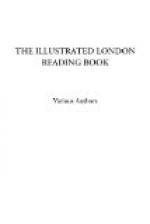[Illustration: ATHENS.]
At the close of the late Greek war Athens was in a dreadful state, being little more than a heap of ruins. It was declared by a Royal ordinance of 1834 to be the capital of the new kingdom of Greece, and in the March of that year the King laid the foundation-stone of his palace there. In the hill of Areopagus, where sat that famous tribunal, we may still discover the steps cut in the rock by which it was ascended, the seats of the judges, and opposite to them those of the accuser and accused. This hill was converted into a burial-place for the Turks, and is covered with their tombs.
Ancient of days! august Athena!
where,
Where are thy
men of might—thy grand in soul?
Gone, glimmering through the
dream of things that were—
First in the race
that led to Glory’s goal;
They won, and
passed away. Is this the whole?
A schoolboy’s tale,
the wonder of an hour!
The warrior’s
weapon and the sophist’s stole
Are sought in vain, and o’er
each mouldering tower,
Dim with the mist of years,
gray flits the shade of power.
Here let me sit, upon this
massy stone,
The marble column’s
yet unshaken base;
Here, son of Saturn, was thy
fav’rite throne—
Mightiest of many
such! Hence let me trace
The latent grandeur
of thy dwelling-place.
It may not be—nor
ev’n can Fancy’s eye
Restore what time
hath labour’d to deface:
Yet these proud pillars, claiming
sigh,
Unmoved the Moslem sits—the
light Greek carols by.
BYRON.
[Illustration: THE PNYX AT ATHENS.]
* * * * *
THE ISLES OF GREECE.
[Illustration: Letter T.]
The Isles of Greece! the Isles
of Greece!
Where burning
Sappho loved and sung—
Where grew the arts of war
and peace,
Where Delos rose
and Phoebus sprung!
Eternal summer gilds them
yet,
But all except their sun is
set.
The Scian and the Teian muse,
The hero’s
harp, the lover’s lute,
Have found the fame your shores
refuse;
Their place of
birth alone is mute,
To sounds which echo further
west
Than your sires’ “Islands
of the Blest.”




